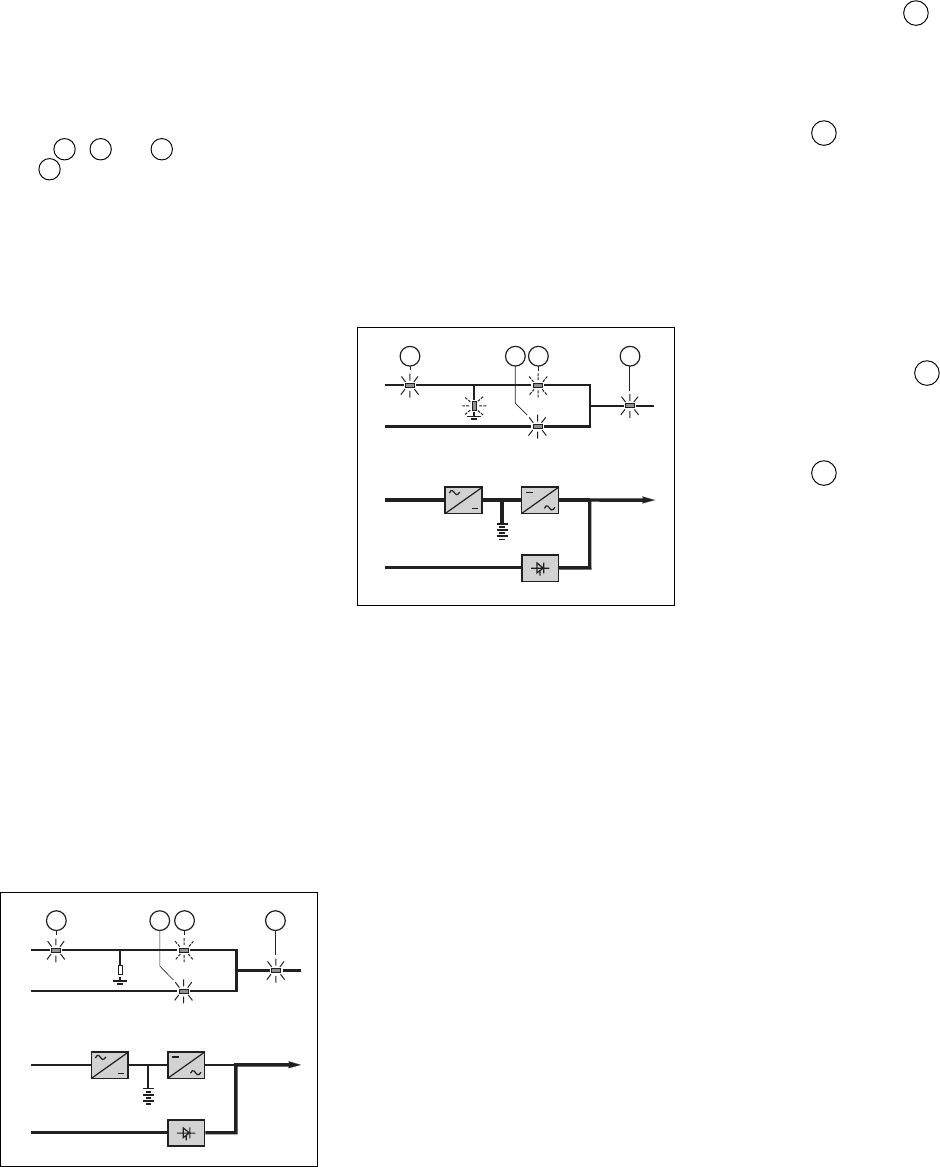
10 - E-51028230XT/BG
Introduction (cont.)
Operation with bypass AC
source restored
◗ no battery discharge (see figure 11).
When bypass AC source power supply
(2) is restored or returns to within
specified tolerances, the load is
transferred back to the static bypass
(C), without an interruption in the
supply of power.
Note: this operating mode does not
depend on the status of the normal AC
source, which may be within or outside
the specified tolerances.
◗ after battery discharge (see figure
12).
Operation of the rectifier/charger (A)
with the battery (D) is identical to that
presented in the section on on-line
mode operation above.
Forced transfer and return
transfer
◗ forced transfer. When the load is
supplied via the static bypass (C), it
may be transferred to the inverter (B)
by pressing pushbutton 2
0 (see figure
19 in the "control panel" section).
The message "FORCED TRANSFER
TO INVERTER REQUESTED, POWER
TO LOAD MAY BE INTERRUPTED" is
displayed. Confirmation by pressing
pushbutton 1
2 is required to effectively
force transfer. The message "LOAD
FORCED TO INVERTER, ECO MODE"
is displayed. Whatever the status of the
bypass AC source, a return to normal
operation in "ECO" mode is possible
only through a forced return transfer to
the static bypass (C).
◗ forced disconnection: as the load is
supplied by the inverter (B), it can be
transferred to the bypass AC source
(M2) via the static bypass (C) by
pressing the pushbutton 2
0 . The
message "FORCED TRANSFER TO
M2 REQUESTED, POWER TO LOAD
MAY BE INTERRUPTED" is then
displayed. Confirmation by pressing
pushbutton 1
2 is required for
disconnection.
Note:
There are two possibilities: the bypass
AC source is within tolerances or
outside tolerances. In the first case, the
UPS in "ECO" mode returns to normal
operation.
In the second case, the transfer will
take place with a power cut to the load
if the bypass AC source is present, or
the load will cease to be supplied if it is
absent. In both cases, the display reads
"LOAD NOT PROTECTED, ECO
MODE".
Caution:
Return to normal operation of the
installation in the "ECO" mode is
possible only after the bypass AC
source has returned to within specified
tolerances.
Operation in "ECO"
mode
Normal operation
See figure 11.
The power required by the load is
supplied by the bypass AC source (2),
via the static bypass (C). The rectifier/
charger (A) supplies the power required
to float charge and recharge the battery
(D).
Lights
1 , 3 and 5 shine green and
light
4 flashes green. The message
"LOAD PROTECTED, ECO MODE" is
displayed.
Operation with the bypass
AC source outside
tolerances
Whatever the status of the normal AC
source, operation of the rectifier/
charger (A) with the battery (D) is
identical to that presented in the section
on on-line mode operation above.
When bypass AC source (2)
characteristics are outside tolerances
(voltage: ±10%; frequency as per
personalisation; phase sync with
inverter ±3°), the load is supplied via
the inverter (B).
From then on, the minimum operating
time on the inverter (B) is 2 minutes
even if the bypass AC source returns to
within specified tolerances. Refer to
figure 7 in the general appendix if the
normal AC source is present, and to
figure 8 if it is absent. After this 2
minute period, the load is immediately
transferred to the bypass AC source
when the latter returns to within
specified tolerances.
Note:
The maximum transfer time of the load
from the static bypass (C) to the
inverter (B) is 15 ms.
Fig. 12
1
2
AB
C
D
2
1
3 5
1
4
Fig. 11
1
2
AB
C
D
5
2
1
41 3


















